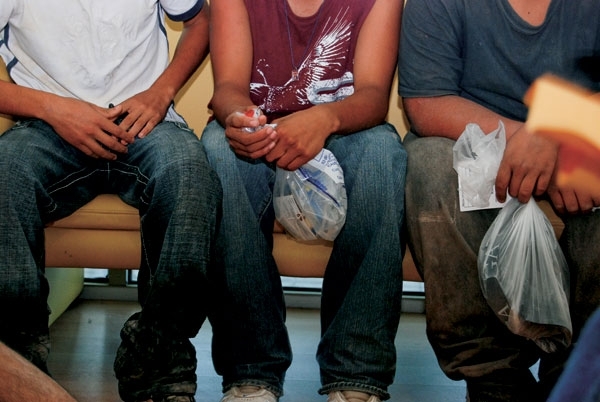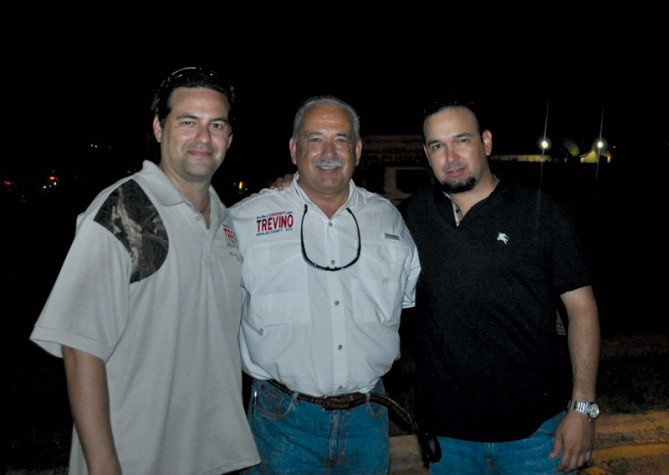
Todd Miller
Todd Miller, a Tucson-based freelance journalist, has covered the U.S.-Mexico borderlands for the last 15 years for publications, including Mother Jones, The Nation and Salon. His new book, “Border Patrol Nation: Dispatches from the Frontlines of Homeland Security,” explores how the post-9/11 border security bonanza has gone global, morphing into a multi-billion dollar worldwide industry or as Miller calls it, “the new world border.”
At home, border militarization is spreading into the interior of the country with SWAT-style immigration raids, increasing surveillance and checkpoints. And abroad, the U.S. Border Patrol is exporting its training techniques and resources to countries such as Iraq, Afghanistan and the Dominican Republic. Miller combines on-the-ground reporting with extensive research to expose the booming industry for military-grade weaponry, cutting-edge surveillance technology and prisons where corporations and politicians profit, while communities suffer the consequences.
Miller’s book is surprising and alarming, even for people, like me, who’ve covered the border for many years. I spoke with Miller recently about his new book.
Texas Observer: You cover a lot of territory in this book. It’s a very thorough examination of how the notion of border security and the U.S. Border Patrol has changed since 9/11.
Todd Miller: Yes, I wanted to really focus on the expansion of the agency and what that means in one sense and also look at some of the not so obvious, yet powerful manifestations of the expansion.
TO: What are some of the less obvious manifestations?
TM: One that I really focus on in the book is money. The idea that there is a private sector increasingly attached to this world of the Border Patrol and border security. If you look at Border Patrol agents they are just one part of a larger systemic world where more and more private interests are involved. One thing I do is go to border security trade shows and talk to vendors from different companies trying to sell their products in what they call the border security market. I talk to Raytheon, Lockheed Martin and other big military companies as well as startup companies interested in this market. Projections show it’s a market growing at an annual 5 percent clip. In 2013 it was a $20 billion global market and if you add in homeland security and emergency management services we’re talking about a $544 billion market.
TO: You wrote that what was once a border reality has become a national reality. Could you expand on that?
TM: One of the things I do is spend extensive time on the northern U.S. border. I went to places like Detroit, Buffalo and even Syracuse. In western New York people have never seen these green striped vehicles before and all of sudden there’s checkpoints and roving patrols. There are more people being pulled over and more police collaborating with immigration. In New York state if you’re pulled over and don’t speak English they will call Border Patrol. They don’t have SB 1070 like Arizona but I interviewed a woman who was driving to the grocery story outside of Rochester, New York, when she was pulled over by the local police. She couldn’t produce a driver’s license so they called Border Patrol and she was detained for a month and then deported.
There are all kinds of stories like that in many places where you’ve never had stories like that before and it’s taken many people by surprise. In Erie, Pennsylvania, it’s much like Rochester—it’s not near a border crossing. It’s actually on a lakeshore, but it’s considered an international border because the borderline is 12 miles out on the lake. Alan Bersin, the former chief of U.S. Customs and Border Protection, said a threat of terrorism was more likely to come from the Canadian border than on the U.S Mexico border. There’s way more agents and resources on the southern border but the buildup has increased at a much higher rate on the northern border, especially since 2005. Another aspect is the increased operations of Immigration and Customs Enforcement in the interior of the country. Border Patrol agents can operate within 100 miles of an international border but ICE, with its increasing collaboration with law enforcement under different agreements like 287g and Secure Communities, can operate anywhere. The way people are being arrested and deported often in the interior of country there’s a semblance of that reality from the southern border moving north and into the interior of the country.
TO: In the book you talk about growing up in Niagara Falls and about the economic collapse of your town and then the expansion of the homeland security state in and around Niagara Falls. Can you talk about that a little?
TM: When I say I’m from Niagara Falls most people think I’m from Canada mainly because that’s where most tourists go to see the falls. Niagara is a border town and I grew up on the New York side of it. It’s mostly an industrial town that’s relied on the chemical and metallurgical industries. In the last 20 years it’s been in economic decline. Many of the companies have left. Now when you go there it’s a very tragic scenario. The city of Niagara has about 35 percent poverty. There’s potholes everywhere and collapsing homes. The town seems like it’s dying but at the same time in the last five or six years we’ve seen a lot of growth of the Border Patrol in Niagara Falls. It’s quite astonishing for me, because I’ve lived in the Arizona borderlands for a long time now, so when I see one of the green and white striped Border Patrol vehicles in Niagara, I feel like I’m in Arizona or Texas. It’s almost surreal but it’s happening. You have a city that’s collapsing but the Border Patrol is growing and they are working with the Niagara Falls Police Department and they have all of these resources. The Border Patrol’s Buffalo sector headquarters has huge video walls, high-powered surveillance cameras and all of this really expensive technology, plus these shiny new vehicles and all of these resources in a city that is economically collapsing, so it’s quite startling.
TO: It sounds like they might be the only employer hiring in Niagara these days?
TM: It’s definitely one of the only agencies that seem to be growing. Perhaps the Niagara Police Department is hiring as well.
TO: How are the role of the Border Patrol and the notion of border security expanding outside of the United States? You call it “the new world border.” And there are some interesting examples you cite like the recordings that were broadcast by the U.S. government from airplanes over Haiti after the earthquake that said, “Don’t even think about coming to the United States.”
TM: I spent a lot of time doing research on the Dominican-Haitian border. The reason I went there is because the Dominican Republic formed its own Border Patrol in 2007 at the urging of the United States. And it turns out that the United States also helped the Dominican Republic with the resources to form their own border patrol and U.S. Border Patrol agents went to the Dominican Republic to give trainings and help the new force get off its feet. I went there and met with some border guards from the Dominican Republic on the northern Dominican-Haitian border. What you see is a very rudimentary version of the U.S.-Mexico border. The Dominican Republic has put up a wall but it looks more like protest barricades. There are agents sitting and watching their patch of border and making sure that no one gets across.
It’s a phenomenon that’s happening globally. There’ve been over 100 countries that the U.S. Border Patrol has traveled to give trainings on border security and in some cases help other countries form their own border policing units. Especially in the case of Iraq where they’ve been going for about seven years now and helping Iraq form it’s own border police—the same with Afghanistan. Wherever the United States has had some serious military efforts abroad that’s where we’ll then follow up with this notion of border security. In Central America if you look at some of the money the U.S. is giving to Central American countries, especially in the drug war effort, there’s money designated for different Central American countries to increase their border security and Border Patrol agents have gone into places like Honduras and Guatemala. And so you see it’s more and more of an international phenomenon. When I go to border security trade fairs there’s a significant foreign presence as more and more countries ramp up their border policing apparatus. That’s why the global market is increasing at 5 percent and it’s becoming a booming market.
TO: Who’s competing with the U.S. in this booming border security market?
TM: When I talk to experts in the United States they often cite Israel as a leader as far as this idea of development of national security technology used on a border. Israel is leading the charge. The University of Arizona has a science and technology park and they are one of the first that is actively trying to develop a border security cluster in the U.S., at least according to its CEO. They are trying to attract all kinds of companies who work on border security, border management technologies. I asked the CEO if it would be the most significant cluster of its kind in the world and he said, ‘No, Israel has the most significant cluster in the world’. This will be the first of its kind in the United States.
TO: So, do you think most Americans are unaware of all of these huge changes in border security?
TM: Yeah, I do. If you look at immigration reform and the ongoing debate rarely are the for profit interests mentioned. For instance, with the Senate passage of the immigration bill last June there was $46 billion going to border security technology, drones etc. You have all these private interests invested in this legislation passing with a huge package for border security. It’s something that needs to be talked about because it’s a significant actor especially if they have lobbyists in Washington. You go to a trade show and last year at the main one in Phoenix everyone was talking about immigration reform like a treasure trove for border security interests. That part of the comprehensive immigration reform package is not being debated. The reason not many people know about it, is because it’s not being discussed as it should be.







